BOLT (Nominal diameter)
NUT (Nominal diameter)
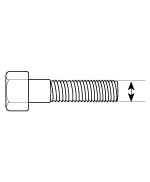

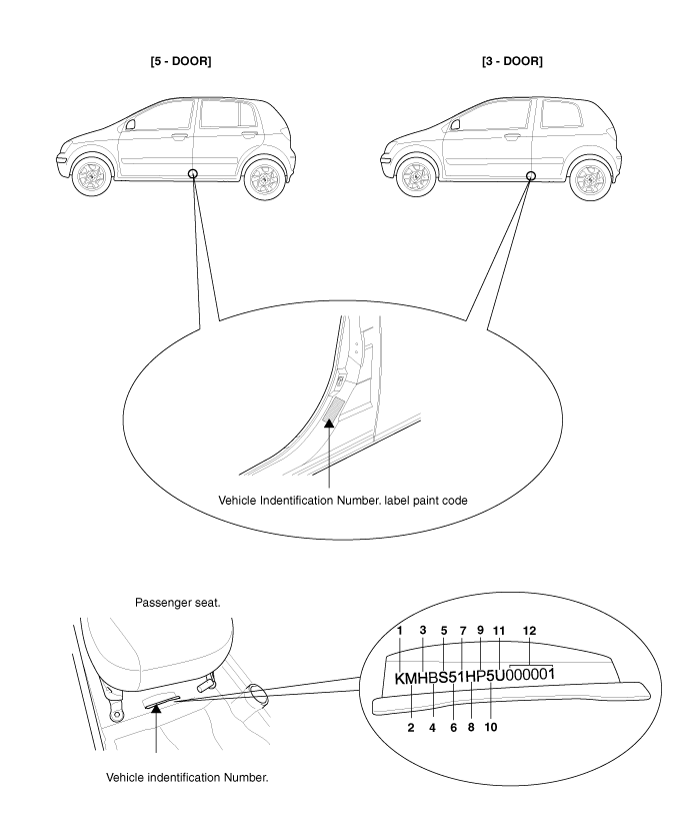

Geographic zone
- K : Korea
Manufacturer
- M : Hyundai motor company
Vehicle type
- H : Passenger
Vehicle line
- B : GETS
Model & Series
- S : STANDAD (L)
- T : DELUXE (GL)
- U: SUPER DELUXE (GLS)
Body type
- 3 : Sedan 3-door
- 5 : Sedan 5-door
Restraint system
- 0 : None
- 1 : Both side - Active belt
- 2 : Both side - Passive belt
- 3 : Driver side - Active belt & Air bag
- 4 : Driver side & Passenger side - Active belt + Air bag
Passenger side - Active belt or passive belt
Engine type
- B : Gasoline 1.6 CVVT
- G : Gasoline 1.1 SOHC
- D : Gasoline 1.4 DOHC
- V : Diesel 1.5
Check digit or others
- P : LHD
- R : RHD
Production year
- 5 : 2005, 6 : 2006
Plant of production
- U : Ulsan (korea)
Vehicle production sequence number
- 000001 ~ 999999
CODE | COLOR |
NW | Noble White |
EB | Ebony Black |
HL | Hiphop Red |
3E | Bule Onyx |
5S | Space Silver |
9G | Gold Beige |
3W | Sheer Yellow |
N8 | Orange |
G8 | Light Green |
2B | Sky Blue |
2M | Midnight Gray |
8N | Leaf Green |

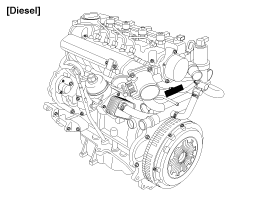

Engine fuel
- G : Gasoline
- D : Diesel
Engine range
- 4 : 4 cycle 6 cylinder
Engine development order
- E : Alpha engine
- F : U-engine
- H : Epsilon engine
Engine capacity
- D : 1,085 cc (Epsilon), 1,599cc (Alpha)
- E : 1,399 cc (Epsilon)
- A : 1,493cc (U-engine)
Production year
- 5 : 2005, 6 : 2006
Engine production sequence number
- 000001 ~ 999999

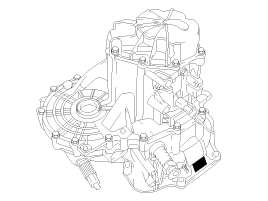

1 : Model
- P : M5CF2
- M : M5AF3
2 : Production year
- 5 : 2005, 6 : 2006, 7 : 2007
3 : Gear ratio
1767 : 3.941
2073 : 3.650
4 : Transaxle production sequence number
- 000001 ~ 999999


1 : Modle
- T : A4AF3
2 : Production year
- 5 : 2005, 6 : 2006, 7 : 2007
3 : Gear ratio
- N : 4.041
4 : Detailed chassification
- XD : 1.4 DOHC
- YD : 1.6 CVVT
5 : Spare
6 : Transaxle production sequence number
- 000001 ~ 999999
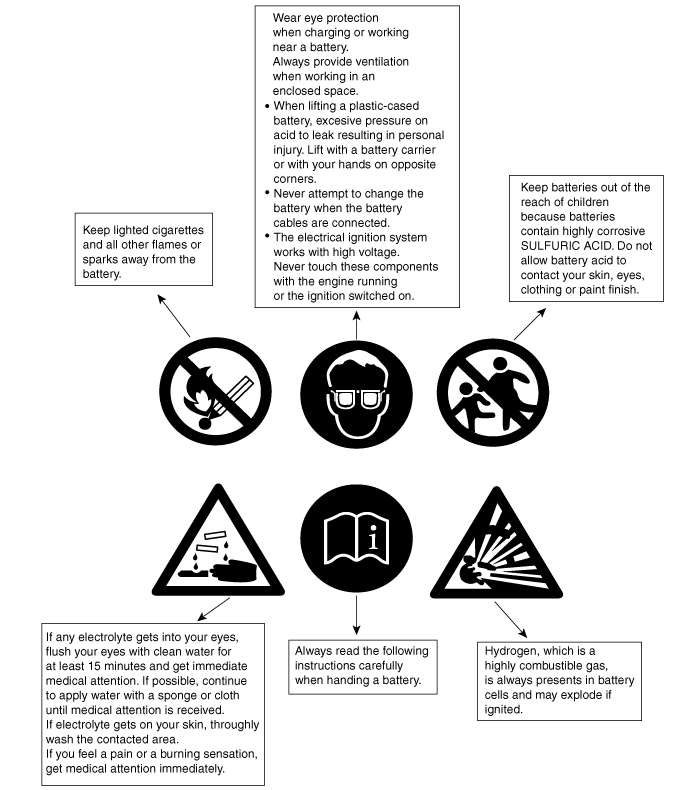
When heavy rear components such as suspension, fuel tank, spare tire, tailgate and trunk lid are to be removed, place additional weight in the luggage area before hoisting. When substatial weight is removed from the rear of the vehicle, the center of gravity may change and cam cause the vehicle to tip forward on the hoist.
Since each tire/wheel assembly weights approximately 30lbs (14kg), placing the front wheels in the luggage area can assist with the weight distribution.
Use the same support points to support the vehicle on safety stands.
Place the lift blocks under the support points as shown in the illustration.
Raise the hoist a few inches (centimeters) and rock the vehicle to be sure it is firmly supported.
Raise the hoist to full height to inspect the lift points for secure support.
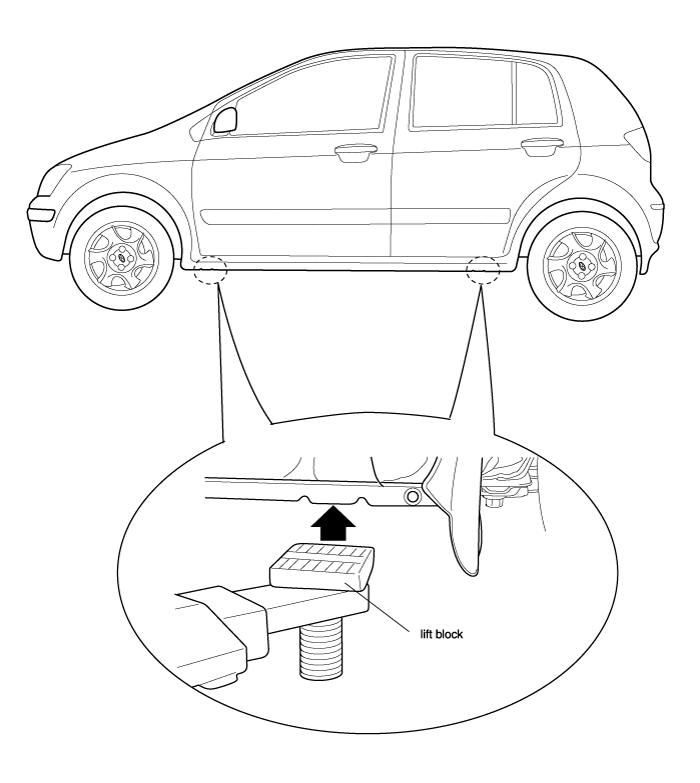
If the vehicle needs to be towed, a wheel lift or as flat-bed method is recommended.
Never tow the vehicle by the method of a suspension (front or rear) lift.

The radiator lower member is not equipped to the vehicle. So, the vehicle's cooling system including radiator and condenser, under cover and front bumper can be damaged.
The towing hook is located in the right inside of the front bumper. There is no support point for a sling - type equipment.
There is no engine center member and suspension frame in the vehicle.
With manual transaxle
Release the parking brake.
Shift the transaxle in neutral.
With automatic transaxle
Release the parking brake.
Start the engine.
Shift to P position, then N position.
Turn off the engine.
Front wheel - lift towing is required.
It is best way to tow the vehicle no farther than 25 Km / h, and keep the speed below 40Km / h.
If you cannot shift the transaxle or start the engine, the vehicle must be transported on a flat - bed truck.
Trying to lift or tow the vehicle by the bumpers will cause serious damage.
BOLT (Nominal diameter) | NUT (Nominal diameter) | ||
 |  |
BOLT/NUT Thin screw | Torque Nm (kg.m, Ib-ft) | |||
Nominal diameter. (mm) | Pitch [mm (in.) ] | 4T | 8T | 10T |
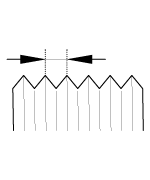 | 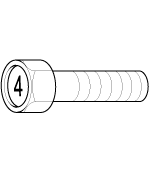 | 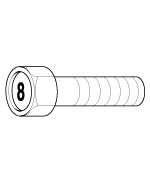 |  | |
M5 | 0.8 (0.031) | 2.0 ~ 3.0 (0.2 ~ 0.3, 1.4 ~ 2.2) | 4.9 ~ 6.9 (0.5 ~ 0.7, 3.6 ~ 5.1) | 7.8 ~ 10.8 (0.8 ~ 1.1, 5.8 ~ 8.0) |
M6 | 1 (0.039) | 2.9 ~ 4.9 (0.3 ~ 0.5, 2.2 ~ 3.6) | 8.8 ~ 12.7 (0.9 ~ 1.3, 6.5 ~ 9.4) | 13.7 ~ 18.6 (1.4 ~ 1.9, 10.1 ~ 13.7) |
M8 | 1.25 (0.049) | 8.8 ~ 11.8 (0.9 ~ 1.2, 6.5 ~ 8.7) | 22.6 ~ 30.4 (2.3 ~ 3.1, 16.6 ~ 22.4) | 33.3 ~ 44.1 (3.4 ~ 4.5, 24.6 ~ 32.5) |
M10 | 1.5 (0.059) | 16.7 ~ 22.6 (1.7 ~ 2.3, 12.3 ~ 16.6) | 45.1 ~ 60.8 (4.6 ~ 6.2, 33.3 ~ 44.8) | 65.7 ~ 88.3 (6.7 ~ 9.0, 48.5 ~ 65.1) |
M12 | 1.75 (0.068) | 29.4 ~ 39.2 (3.0 ~ 4.0, 21.7 ~ 28.9) | 78.5 ~ 105.9 (8.0 ~ 10.8, 57.9 ~ 78.1) | 114.7 ~ 154.9 (11.7 ~ 15.8, 84.6 ~ 114.3) |
M14 | 2 (0.078) | 47.1 ~ 63.7 (4.8 ~ 6.5, 34.7 ~ 47.0) | 125.5 ~ 169.7 (12.8 ~ 17.3, 92.6 ~ 125.1) | 183.4 ~ 249.1 (18.7 ~ 25.4, 135.3 ~ 183.7) |
M16 | 2 (0.078) | 73.5 ~ 100.0 (7.5 ~ 10.2, 54.2 ~ 73.8) | 197.1 ~ 266.7 (20.1 ~ 27.2, 145.4 ~ 196.7) | 288.3 ~ 390.3 (29.4 ~ 39.8, 212.7 ~ 287.9) |
M20 | 2.5 (0.098) | 144.2 ~ 195.2 (14.7 ~ 19.9, 106.3 ~ 143.9) | 396.2 ~ 535.4 (40.4 ~ 54.6, 292.2 ~ 394.9) | 565.8 ~ 764.9 (57.7 ~ 78.0, 417.3 ~ 564.2) |
M24 | 3 (0.118) | 249.1 ~ 337.3 (25.4 ~ 34.4, 183.7 ~ 248.8) | 687.4 ~ 929.7 (70.1 ~ 94.8, 507.0 ~ 685.7) | 975.8 ~ 1320.0 (99.5 ~ 134.6, 719.7 ~ 973.6) |
M30 | 3.5 (0.137) | 499.2 ~ 674.7 (50.9 ~ 68.8, 368.2 ~ 497.6) | 1372.9 ~ 1858.4 (140.0 ~ 189.5, 1012.6 ~ 1370.7) | 1956.4 ~ 2647.8 (199.5 ~ 270.0, 1443.0 ~ 1952.9) |
BOLT/NUT Thin screw | Torque Nm (kg.m, Ib-ft) | |||
Nominal diameter. (mm) | Pitch [mm (in.) ] | 4T | 8T | 10T |
 |  |  |  | |
M5 | 0.5 (0.019) | 2.0 ~ 3.0 (0.2 ~ 0.3, 1.4 ~ 2.2) | 5.9 ~ 8.8 (0.6 ~ 0.9, 4.3 ~ 6.5) | 8.8 ~ 12.7 (0.9 ~ 1.3, 6.5 ~ 9.4) |
M6 | 0.75 (0.029) | 3.9 ~ 4.9 (0.4 ~ 0.5, 2.9 ~ 3.6) | 9.8 ~ 13.7 (1.0 ~ 1.4, 7.2 ~ 10.1) | 14.7 ~ 20.6 (1.5 ~ 2.1, 10.8 ~ 15.2) |
M8 | 1 (0.039) | 8.8 ~ 11.8 (0.9 ~ 1.2, 6.5 ~ 8.7) | 24.5 ~ 32.4 (2.5 ~ 3.3, 18.1 ~ 23.9) | 35.3 ~ 48.1 (3.6 ~ 4.9, 26.0 ~ 35.4) |
M10 | 1.25 (0.049) | 17.7 ~ 23.5 (1.8 ~ 2.4, 13.0 ~ 17.4) | 47.1 ~ 63.7 (4.8 ~ 6.5, 34.7 ~ 47.0) | 69.6 ~ 94.1 (7.1 ~ 9.6, 51.4 ~ 69.4) |
M12 | 1.25 (0.049) | 32.4 ~ 44.1 (3.3 ~ 4.5, 23.9 ~ 32.5) | 86.3 ~ 117.7 (8.8 ~ 12.0, 63.7 ~ 86.8) | 127.5 ~ 172.6 (13.0 ~ 17.6, 94.0 ~ 127.3) |
M14 | 1.5 (0.059) | 51.0 ~ 69.6 (5.2 ~ 7.1, 37.6 ~ 51.4) | 136.3 ~ 185.3 (13.9 ~ 18.9, 100.5 ~ 136.7) | 201.0 ~ 271.6 (20.5 ~ 27.7, 148.3 ~ 200.4) |
M16 | 1.5 (0.059) | 79.4 ~ 107.9 (8.1 ~ 11.0, 58.6 ~ 79.6) | 211.8 ~ 286.4 (21.6 ~ 29.2, 156.2 ~ 211.2) | 311.8 ~ 421.7 (31.8 ~ 43.0, 230.0 ~ 311.0) |
M20 | 1.5 (0.059) | 163.8 ~ 221.6 (16.7 ~ 22.6, 120.8 ~ 163.5) | 448.2 ~ 607.0 (45.7 ~ 61.9, 330.5 ~ 447.7) | 639.4 ~ 864.9 (65.2 ~ 88.2, 471.6 ~ 638.0) |
M24 | 2 (0.078) | 276.5 ~ 373.6 (28.2 ~ 38.1, 204.0 ~ 275.6) | 759.0 ~ 1026.8 (77.4 ~ 104.7, 559.8 ~ 757.3) | 1080.7 ~ 1462.2 (110.2 ~ 149.1, 797.1 ~ 1078.4) |
M30 | 2 (0.078) | 562.9 ~ 762.0 (57.4 ~ 77.7, 415.2 ~ 562.0) | 1553.4 ~ 2102.5 (158.4 ~ 214.4, 1145.7 ~ 1550.8) | 2210.4 ~ 2991.0 (225.4 ~ 305.0, 1630.3 ~ 2206.1) |
Flange BOLT (Nominal diameter) | Flange NUT (Nominal diameter) | ||
 |  |
Flange BOLT/NUT Normal screw | Torque Nm (kg.m, Ib-ft) | |||
Nominal diameter. (mm) | Pitch [mm (in.) ] | 4T | 8T | 10T |
 | 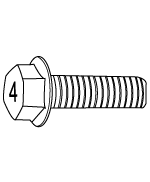 | 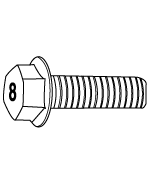 | 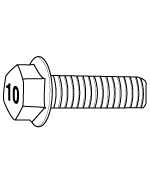 | |
M5 | 0.8 (0.031) | 2.0 ~ 2.9 (0.2 ~ 0.3, 1.4 ~ 2.2) | 5.9 ~ 7.8 (0.6 ~ 0.8, 4.3 ~ 5.8) | 8.8 ~ 11.8 (0.9 ~ 1.2, 6.5 ~ 8.7) |
M6 | 1 (0.039) | 3.9 ~ 4.9 (0.4 ~ 0.5, 2.9 ~ 3.6) | 9.8 ~ 13.7 (1.0 ~ 1.4, 7.2 ~ 10.1) | 14.7 ~ 19.6 (1.5 ~ 2.0, 10.8 ~ 14.5) |
M8 | 1.25 (0.049) | 8.8 ~ 11.8 (0.9 ~ 1.2, 6.5 ~ 8.7) | 24.5 ~ 32.4 (2.5 ~ 3.3, 18.1 ~ 23.9) | 35.3 ~ 48.1 (3.6 ~ 4.9, 26.0 ~ 35.4) |
M10 | 1.5 (0.059) | 17.7 ~ 24.5 (1.8 ~ 2.5, 13.0 ~ 18.1) | 48.1 ~ 65.7 (4.9 ~ 6.7, 35.4 ~ 48.5) | 70.6 ~ 96.1 (7.2 ~ 9.8, 52.1 ~ 70.9) |
M12 | 1.75 (0.068) | 31.4 ~ 43.1 (3.2 ~ 4.4, 23.1 ~ 31.8) | 84.3 ~ 113.8 (8.6 ~ 11.6, 62.2 ~ 83.9) | 123.6 ~ 167.7 (12.6 ~ 17.1, 91.1 ~ 123.7) |
M14 | 2 (0.078) | 51.0 ~ 68.6 (5.2 ~ 7.0, 37.6 ~ 50.6) | 135.3 ~ 182.4 (13.8 ~ 18.6, 99.8 ~ 134.5) | 198.1 ~ 268.7 (20.2 ~ 27.4, 146.1 ~ 198.2) |
M16 | 2 (0.078) | 79.4 ~ 107.9 (8.1 ~ 11.0, 58.6 ~ 79.6) | 212.8 ~ 288.3 (21.7 ~ 29.4, 157.0 ~ 212.7) | 311.8 ~ 421.7 (31.8 ~ 43.0, 230.0 ~ 311.0) |
Flange BOLT/NUT Thin screw | Torque Nm (kg.m, Ib-ft) | |||
Nominal diameter. (mm) | Pitch [mm (in.) ] | 4T | 8T | 10T |
 |  |  |  | |
M5 | 0.5 (0.019) | 2.9 ~ 2.9 (0.3 ~ 0.3, 2.2 ~ 2.2) | 6.9 ~ 8.8 (0.7 ~ 0.9, 5.1 ~ 6.5) | 9.8 ~ 13.7 (1.0 ~ 1.4, 7.2 ~ 10.1) |
M6 | 0.75 (0.029) | 3.9 ~ 5.9 (0.4 ~ 0.6, 2.9 ~ 4.3) | 10.8 ~ 14.7 (1.1 ~ 1.5, 8.0 ~ 10.8) | 16.7 ~ 21.6 (1.7 ~ 2.2, 12.3 ~ 15.9) |
M8 | 1 (0.039) | 9.8 ~ 12.7 (1.0 ~ 1.3, 7.2 ~ 9.4) | 26.5 ~ 35.3 (2.7 ~ 3.6, 19.5 ~ 26.0) | 38.2 ~ 52.0 (3.9 ~ 5.3, 28.2 ~ 38.3) |
M10 | 1.25 (0.049) | 19.6 ~ 25.5 (2.0 ~ 2.6, 14.5 ~ 18.8) | 51.0 ~ 68.6 (5.2 ~ 7.0, 37.6 ~ 50.6) | 75.5 ~ 102.0 (7.7 ~ 10.4, 55.7 ~ 75.2) |
M12 | 1.25 (0.049) | 35.3 ~ 48.1 (3.6 ~ 4.9, 26.0 ~ 35.4) | 94.1 ~ 126.5 (9.6 ~ 12.9, 69.4 ~ 93.3) | 138.3 ~ 186.3 (14.1 ~ 19.0, 102.0 ~ 137.4) |
M14 | 1.5 (0.059) | 55.9 ~ 75.5 (5.7 ~ 7.7, 41.2 ~ 55.7) | 148.1 ~ 200.1 (15.1 ~ 20.4, 109.2 ~ 147.6) | 216.7 ~ 293.2 (22.1 ~ 29.9, 159.8 ~ 216.3) |
M16 | 1.5 (0.059) | 86.3 ~ 116.7 (8.8 ~ 11.9, 63.7 ~ 86.1) | 229.5 ~ 309.9 (23.4 ~ 31.6, 169.3 ~ 228.6) | 336.4 ~ 455.0 (34.3 ~ 46.4, 248.1 ~ 335.6) |
The torques shown in the table are standard values under the following conditions.
Nuts and bolts are made of galvanized steel bar.
Galvanized plain steel washers are inserted.
All nuts, bolts and plain washers are dry.
The torques shown in the table are not applicable.
When spring washers, toothed washers and the like are inserted.
If plastic parts are fastened.
If self-tapping screws or self-locking nuts are used.
If threads and surfaces are coated with oil.
Parts | Specifications |
Engine oil | API Classification SH OR Above - 1.1 (Gasoline) API Classification SJ/SL OR Above - 1.4/1.6 (Gasoline) API Classification CH OR Above - 1.5 (Diesel) |
Manual transaxle | API Classification GL - 4 (SAE 75W/90 : Gasoline, SAE 75W/85W : Diesel) |
Automatic transaxle | GENUINE HYUNDAI transaxle oil, GENUINE DIAMOND ATF SP - III |
Brake | DOT 3 or DOT 4 |
Cooling system | High quality ethylene glycol - Concentration level 40% (tropical) - Concentration level 50% (tropical) |
Power steering | PSF - 3 |
Transaxle linkage, parking brake cable mechanism, hood lock and hook, door latch, seat adjuster, tailgate latch, door hinges, tailgate hinges | Multipurpose grease NLGI grade #2 |
Always use Genuine Hyundai parts and recommedended fluid.
Using any other type of parts and fluid can cause serious damaged if the vehicle.
Description | Capacities | |||
1.1(Gasoline) | 1.4/1.6(Gasoline) | 1.5(Diesel) | ||
Engine oil | Oil pan | 2.8 (2.96, 2.46) | 3.0 (3.17, 2.64) | 4.0 (4.23, 3.52) |
Oil filter | 0.2 (0.21, 0.18) | 0.3 (0.32, 0.26) | 0.5 (0.53, 0.44) | |
Total | 3.0 (3.17, 2.64) | 3.3 (3.49, 2.90) | 5.3 (5.60, 4.66) | |
Cooling system | 6.0 (6.34, 5.28) | 6.2 (6.55, 5.46) | 6.5 (6.87, 5.72) | |
Manual transaxle | 2.15 (2.27, 1.89) | 2.15 (2.27, 1.89) | 2.0 (2.11, 1.76) | |
Automatic transaxle | - | 6.1 (6.45, 5.37) | - | |
Power steering | 0.9 (0.95, 0.79) | 0.9 (0.95, 0.79) | ||
liter (U.S. qus., lmp.qts.) | ||||
Recommended API classification : SH OR ABOVE - 1.1(Gasoline)
Recommended SAE viscosity grades :
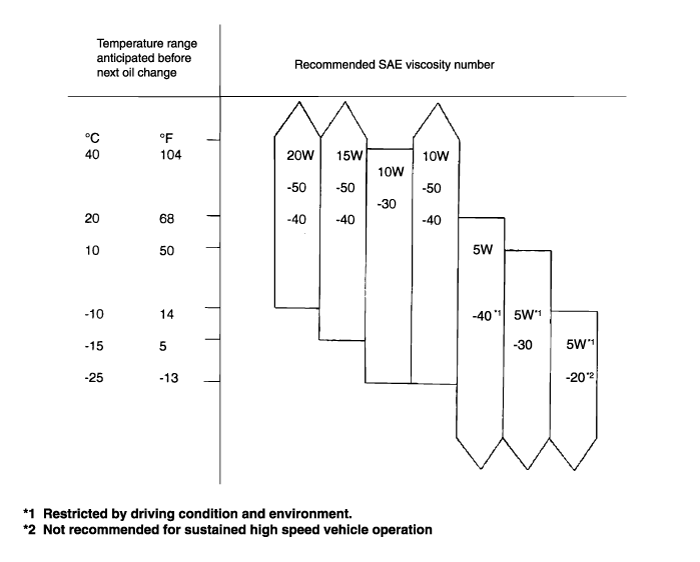
Recommended API classification : SJ/SL OR ABOVE - 1.4/1.6(Gasoline)
Recommended SAE viscosity grades :
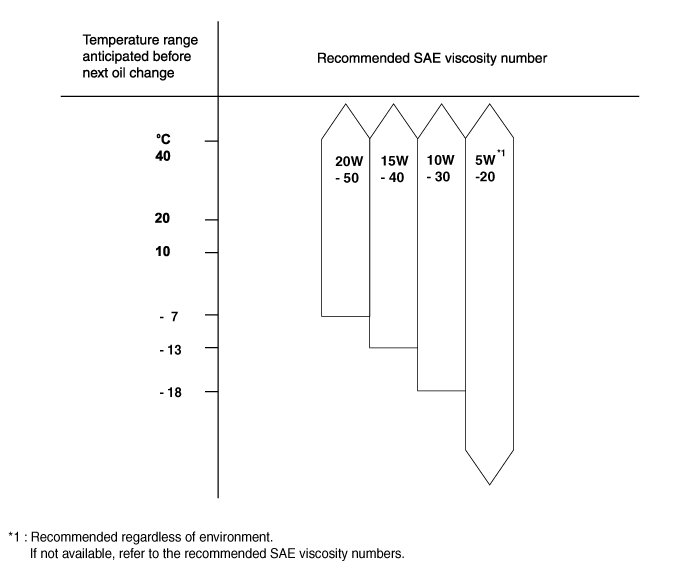
Recommended API classification : CH-4 or ABOVE - 1.5(Diesel)
Recommended ACEA classification : B4 OR ABOVE
Recommended SAE viscosity grades :
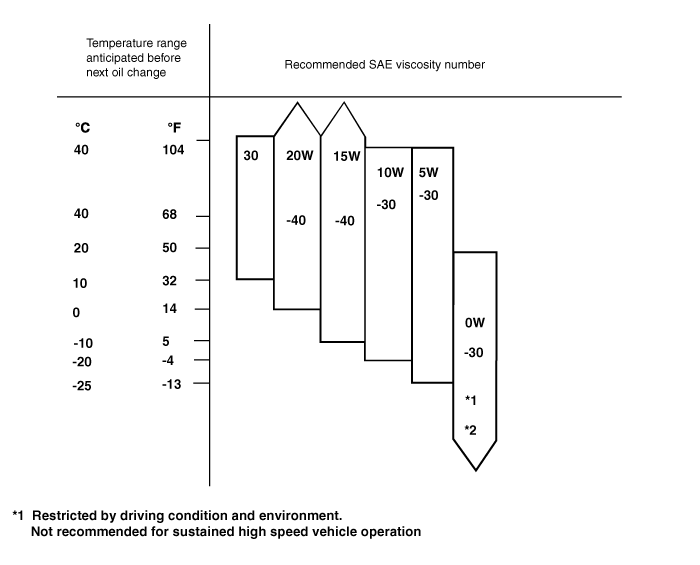
For best performance and maximum protection of all types of operation, select only those lubricants which :
Satisfy the requirements of the API classification.
Have the proper SAE grade number for expected ambient temperature range.
Lubricants which do not have both an SAE grade number and an API service classification on the container should not be used.
Always be sure to cover fenders, seats, and floor areas before starting work.
The support rod must be inserted into the hole near the edge of the hood whenever you inspect the engine compartment to prevent the hood from falling and causing possible injury.
Make sure that the support rod has been released prior to closing the hood. Always check to be sure the hood is firmly latched before driving the vehicle.
Be sure that all necessary tools and measuring equipment are available starting work.
Use special tools when they are required.
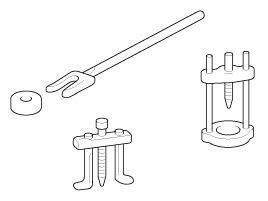
First find the cause of the problem and then determine whether removal or disassembly before starting the job.
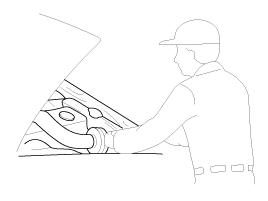
If the disassembly procedure is complex, requiring many parts to be disassembled, all parts should be disassembled in a way that will not aggect their performance or external appearance.
Inspection of parts
Each part, when removed, should be carefulley on spected for malfunction, deformation, damage, and other problems.

Arrangement of parts
All disassembled parts should be carefully arranged for effective reassembly.
Be sure to separate and correctly identify the parts to be repllaced from those that will be used again.
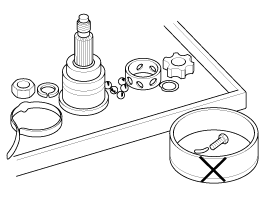
Cleaning parts for reuse
All parts to be used again should be carefully and thoroughly cleaned by an appropriate method.

When replacing parts, use HYUNDAI genuine parts.
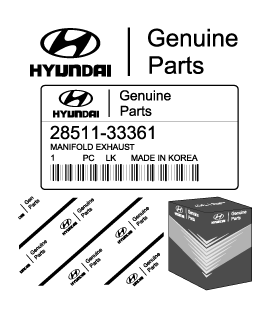
Standard values, such as torques and certain adjustments, must be strictly observed in the reassembly of all parts.
If removed, the following parts should always be replaced with new ones.
Oil seals
Gaskets
O-rings
Lock washers
Cotter pins (split pins)
Plastic nuts
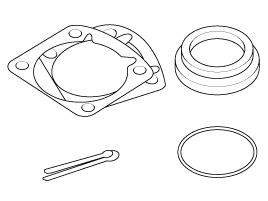
Depending on their location.
Selalant should be applied to gaskets.
Oil should be applied to the moving components of parts.
Specified oil or grease should be applied to the prescribed locations (oil seals, etc) before assembly.
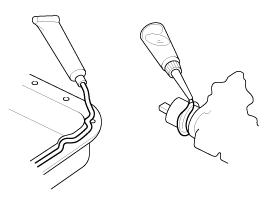
Use gauges and testers to adjust correclty the parts to standard values correctly.
Be sure to disconnect the battery cable from the negative (-) terminal of the battery.
Never pull on the wires when disconnecting connectors.
Locking connectors will click when the connector is secure.
Handle sensors and relays carefully. Be careful not to drop them against other parts.
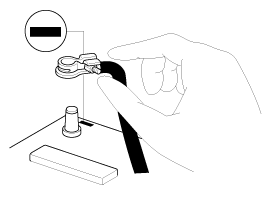
Always prevent gasoline or from touching rubber parts or tubing.
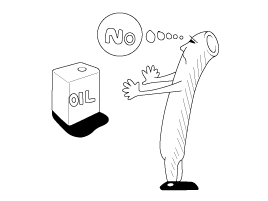
Basically, all measurements in this manual are taken with a tracking gauge.
When a measuring tape is used, check to be sure there is no elongation, twisting or bending.
For measuring dimensions, both projected dimensioners and actual - measurement dimensions are used in this manual.
These are the dimensions measured when the measurement points are projected from the vehicle's surface, and are the reference dimensions used for used for body alterations.
If the length of the tracking gauge probes is adjustable, measure it by lengthening one of two probes as long as the different value in height of the two surface.

These dimensions indicate the actual linear distance between mesaurement points, and are used as the reference dimensions when a tracking gauge is used for measurement.
First adjust both probes to the same length (A=A') before measurement.
Check the probes and gauge itself to make sure there is no free play.
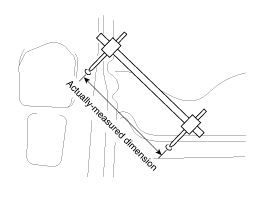
Measurements should be taken at the center fo the hole.
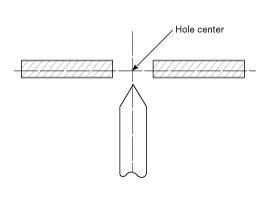
Check the terminal for tightness.
Check terminals and wires for corrosion from battery electrolyte, etc.
Check terminals and wires for open corcuits.
Check wire insulation and coating for damage, cracks and degrading.
Check the conductive parts of terminals for contact with other metallic parts (vehicle body and other parts).
Check grounded parts to verify that there is complete continuity between thier attaching bolt(s) and the vehicle's body.
Check for incorrect wiring.
Check that the wiring is so clamped to the prevent contact with sharp corners of the vehicle body, etc. or hot parts (exhaust manifold, etc.)
Check that the wiring is clamped firmy to provide enough clearance from the fan pulley, fan belt and other rotating or moving parts.
Check that the wiring has a little space so that it can vibrate between fixed and moving parts such as the vehicle body and the engine.
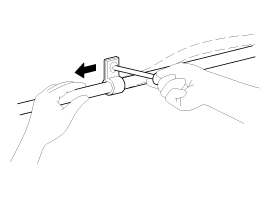
A blade type fuse test taps provided to allow checking the fuse itself without removing if from the fuse box. The fuse is good if the test lamp lights up when one lead is connected to the test taps (one at a time) and the other lead is grounded. (Turn the ignition switch so that the fuse circuit becomes operative)

Prior to servicing the electrical system, be sure to turn off the ignition switch and disconnect the battery ground cable.
When the battery cable is removed, any diagnostic trouble code retained by the computer will be cleared. There fore, if necessary, read the diagnostic before removing the battery cable.
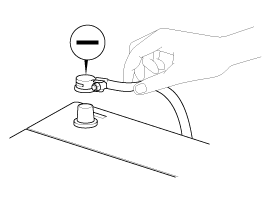
Attach the wiring harnesses with clamps so that there is no slack. However, for any harness which passes the engine or other vibrating parts of the vehicle, allow some slack within a range that does not allow the engine vibrations to cause the harness to come into contact with any of the surronding parts and then secure the harness by using a clamp.

If any section of a wiring harness interferes with the edge of a parts, or a corner, wrap the section of the harness with tape or something similar in order to protect if from damage.
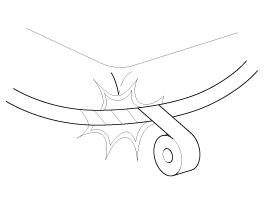
When installing any parts, be careful not to pinch or damage any of the wiring harness.
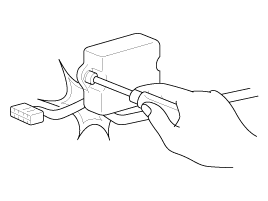
Never throw relays, sensors or electrical parts, or expose them to strong shock.

The electronlic parts used in the computer, relays, etc. are readily damaged by heat. If there is a need for service operations that may cause the temperature to exceed 80°C (176°F), remove the electronic parts before hand.

Loose connectors cause problems. Make sure that the connectors are always securely fastened.
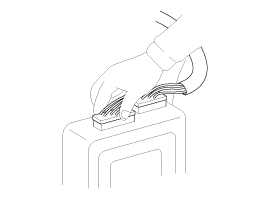
When disconnecting a connector, be sure to grip only the connector, not the wires.
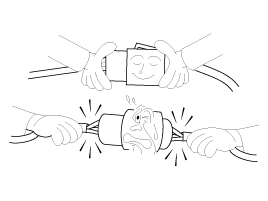
Disconnect connector which have catches by pressing in the direction of the arrows shown the illustration.
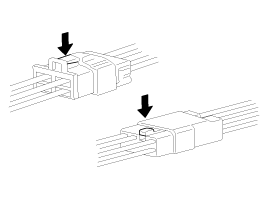
Connect connectors which have catches by inserting the connectors until they make a clicking sound.

When using a circuit tester to check continuity or voltage on connector terminals, insert the test probe into the harness side. If the connector is a sealed connector, insert the test probe through the hole in the rubber cap until contacts the terminal, being careful not to damage the insulation of the wires.
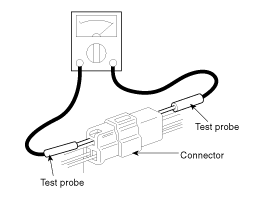
To avoid overloading the wiring, take the electrical current load of the optional equipment into consideration, and determine the appropartate wire size.
Noeminal size | SAE gauge No. | Permissible current | |
In engine compartment | Other areas | ||
0.3mm² | AWG 22 | - | 5A |
0.5mm² | AWG 20 | 7A | 13A |
0.85mm² | AWG 18 | 9A | 17A |
1.25mm² | AWG 16 | 12A | 22A |
2.0mm² | AWG 14 | 16A | 30A |
3.0mm² | AWG 12 | 21A | 40A |
5.0mm² | AWG 10 | 31A | 54A |
If a large amount of unburned gasolined gasoline flow into the converter, it may overheat and create a fire hazard. To prevent this observe the following precations and explain them to your customer.
Use only unleaded gasoline.
Do not run the engine while the car is at rest for a long time. Avoid running the engine at fast idle for more than 10minutes and idle speed for more than 20 minutes.
Avoid start-jump tests. Do start-jumps only when absolutely necessary. Perform this test as rapidly as possible and, while testing, never race the engine.
Do not measure engine compression for and extended time. Engine compression tests must be made as rapidly as possible.
Avoid coasting with the ignition turned and during prolonged braking.
Do not dispose of used catalytic converter together with parts contaminated with gasoline or oil.